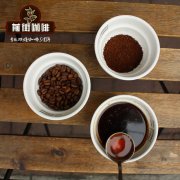Ethiopian Coffee | what is the flavor of the washed coffee in the black plaid skirt treatment field in Yega Xuefei area?

Yega Xuefei production area black plaid skirt processing field
The black plaid skirt processing plant is located in the famous Yega Chuefei production area in Ethiopia. About 500 farmers hand over their coffee beans to the black plaid skirt cleaning station. Small farmers cultivate about 2.5 hectares, and the elevation is between 1850 and 1900 meters. Farmers must send the harvested coffee to the treatment plant immediately. If it takes more than 4 hours, the coffee will ferment and the taste will become very bad. After the end of the coffee season, the processing farm has to work all night until dawn. If you lose time, you will lose Nong Ming's hard work and money. The peel and pulp of coffee cherries are removed, then fermented for 48 hours by washing, and then dried on a high-priced bamboo bed for 7-10 days, depending on God's face.
Name of the farm: Burka Silinga
Producing area: Yirgacheffe Yega Xuefei producing area
Country: Ethiopia
Altitude: 1850-1900 m
Farm area: 500 members
Variety: local traditional variety of Heirloom
Treatment method: washing method
Cup test: a very fresh and clean style, with honey-scented black tea, moderate citrus acidity and a crisp mint finish with crisp blueberry and citrus flavours.
Important Notice :
前街咖啡 FrontStreet Coffee has moved to new addredd:
FrontStreet Coffee Address: 315,Donghua East Road,GuangZhou
Tel:020 38364473
- Prev

How does Malaba form the flavor of Indian coffee?
Coffee was brought into the establishment of the first coffee farm by pilgrims as early as the 16th century, and you might not have imagined that India produces much more coffee than Ethiopia and any Central American country, with 900000 hectares of land growing coffee beans. There are about 140000 coffee farms in India, and more than 90% of the farms are small-scale farming with an area of less than 10 mu, which are located in the south and east.
- Next

Kenya AB Neri Hiriga processing field Bright quality sour and sweet tropical fruit
Kenya is a fine coffee producing country, only the traditional Arabica introduced from England in 1900, until 1950 the most outstanding Bourbon varieties of SL28 and SL34 appeared in Kenya today. Most coffee beans are graded by the Kenya Coffee Board and sold at auction, a system that dates back to before 1934, when auctions were conducted by proxy.
Related
- Detailed explanation of Jadeite planting Land in Panamanian Jadeite Manor introduction to the grading system of Jadeite competitive bidding, Red bid, Green bid and Rose Summer
- Story of Coffee planting in Brenka region of Costa Rica Stonehenge Manor anaerobic heavy honey treatment of flavor mouth
- What's on the barrel of Blue Mountain Coffee beans?
- Can American coffee also pull flowers? How to use hot American style to pull out a good-looking pattern?
- Can you make a cold extract with coffee beans? What is the right proportion for cold-extracted coffee formula?
- Indonesian PWN Gold Mandrine Coffee Origin Features Flavor How to Chong? Mandolin coffee is American.
- A brief introduction to the flavor characteristics of Brazilian yellow bourbon coffee beans
- What is the effect of different water quality on the flavor of cold-extracted coffee? What kind of water is best for brewing coffee?
- Why do you think of Rose Summer whenever you mention Panamanian coffee?
- Introduction to the characteristics of authentic blue mountain coffee bean producing areas? What is the CIB Coffee Authority in Jamaica?

